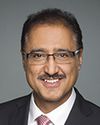Okay.
I think a lot of us are very concerned about this project. Last summer, the CEO of the authority was put on leave. We've also had delays in this project. It was recently announced that the selection from the short list of three contractors will not be made this year but will be delayed well into next year, and possibly even into the fall of next year. Also, we've just recently had the approval permit being granted to the Detroit International Bridge Company to construct a new Ambassador Bridge.
When you put this all together, it could very well be the case that the new Ambassador Bridge will open before this particular bridge, the Gordie Howe bridge. In the context of declining cross-border traffic numbers in recent years, this is a cause for concern. Will we be saddled with a bridge that opens after the new Ambassador Bridge, one that won't be able to generate the tolls necessary to pay for the costs of this bridge, which could be in the $4-billion plus range?
Maybe you could speak to the delays that are taking place and to why it's taking so long, despite parliamentary appropriations for operating and capital costs that have been approved each and every time. Why are these delays are taking place and how sure can we be that this bridge will be completed in the time that has been suggested, which is now 2023, three years after the time in the original commitment that was made? That commitment was made not just by the previous government, I might add, but also by the bridge authority's board and the Michigan governor's office.
Maybe you can speak to these delays. Why are these delays taking place? What is being done to make sure there are no further delays in this bridge, particularly in the context of the permit that the current government has granted for the new Ambassador Bridge?





